In “I Breathed a Body,” released by Aftershock Comics in 2021, writer Zac Thompson revisits technology and our relationship with it, this time merging it with body horror in the vein of David Cronenberg. The monster is rarely just that: a monster, which is a horrific reality. Overall, the monster encapsulates the era’s cultural concerns. Instead, in “I Breathed a Body,” the villain is obsessed with technology and our complicated relationship with it.
The impact of social media on our daily lives is much more important. I was influenced by culture-themed science fiction horror series and breathed a body of social media and huge tech. I Breathed a Body is a supernatural horror film set in a dystopian future in which social media influencers are tested to the breaking point.
When Milo Caliban, the ultimate influencer and prankster, releases an unspeakably bad video, it is up to Anne Stewart, Milo’s social media manager, to benefit from Milo’s craziness while minimizing the reaction that could hurt his bottom line. It is like a mix of The Social Network and Hellraiser.
According to Thompson, one of the occurrences that inspired I Breathed a Body was the viral video in which Logan Paul displayed the body of a man who had committed suicide in Japan’s suicide forest in a vlog on his massively successful YouTube channel.
That incident, as well as Elsagate, a controversy that flared up in November 2017 after The New York Times published an article describing in detail some of the disturbing content that had slipped under the radar of YouTube’s filters and ended up on the YouTube Kids portal, made parents ask what their children were viewing on YouTube all day and how secure it was.
Let us take a closer look at this apocalyptic future, which is remarkably similar to our own.
An Unforeseen Innovation
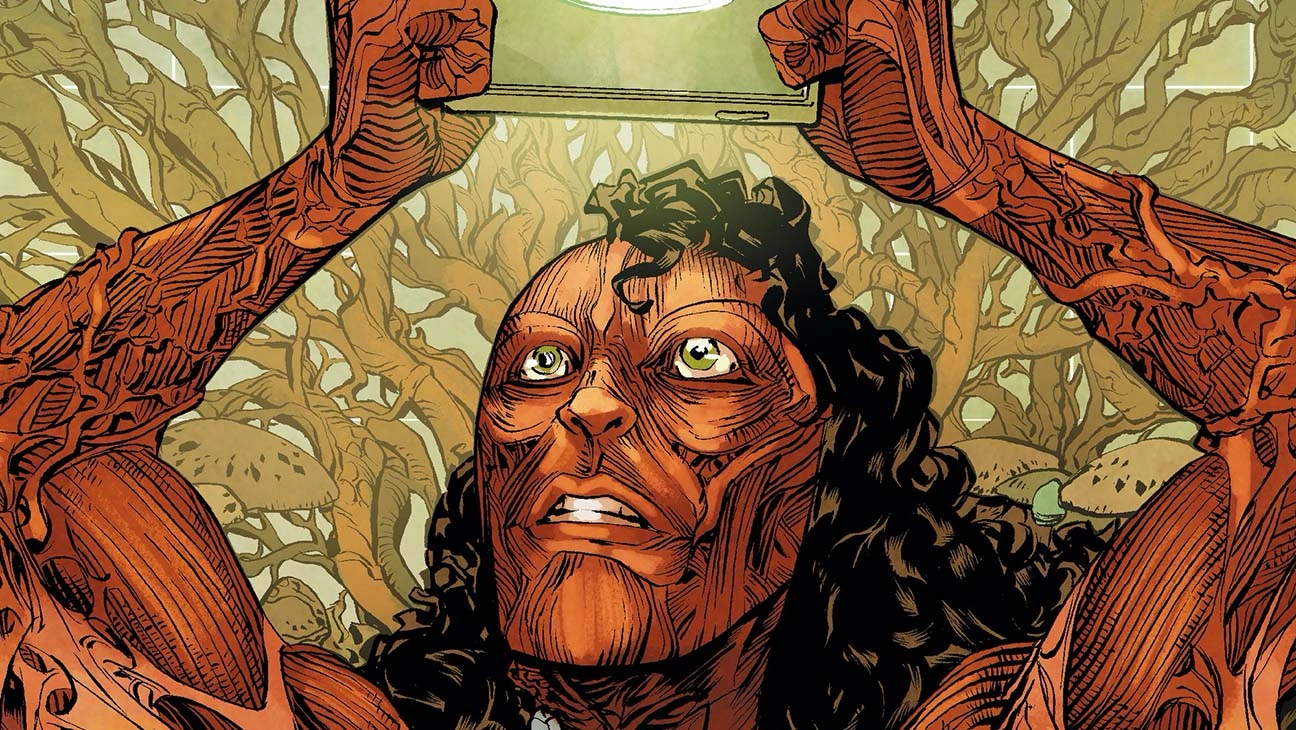
We start the series with something out of a sci-fi movie. A baby with a big head, visible veins, and something attached to its stomach is shown, and it feels like a premonition. The narrator talks about making their name mean something beyond their family and legacy, a want to make it mean something that wields actual power.
They are talking about a new dawn of age, a new kind of social fabric when we see a naked man injecting something into the baby as a woman screams out his name. A nameless entity that has arms that look exactly like the thing coming out of the baby’s stomach attacks the woman.
The flashback ends, and we are back in the present where an internet sensation, Mylo Caliban, has produced a half-hearted apology video which is less of an apology and more of a way to shrug off responsibility. Anne works for Bramwell Caliban-owned corporation, Mycena Biotechnology. It is one of those businesses that have a hand in almost every aspect of society.
Mylo, Bramwell’s son, is the platform’s most popular content producer. “We don’t have to be responsible for what other people do on the internet. At least, that’s what Anne Stewart, the one who edits and wants us to believe Mylo’s apology, is saying while trying to convince herself.
She is watching a video apology that Mylo produced in an attempt to “smooth” the scenario, that his ill-fated prank had created. He had filmed a woman’s death during his stunt, and it is Anne’s job to gaslight his 400 million subscribers into believing him and staying on his side. He is one of the biggest stars on the MyCee social network, and he is managed by Anne.
The apology video is a disaster, but Anne resolves to embrace the situation and test the limits of acceptable behavior. “This apology will only increase the number of people who visit his MyCee page. Here, we’re vying for people’s attention. We need to keep his admirers interested in what we’re doing,” she informs Dalton, the video editor.
Mylo’s father founded the Mycena brand, which now has over 400 million followers and is in serious difficulty–a la Jake-Paul-at-a-suicide-forest sort of trouble. On the other hand, more controversy equals more visibility, and Anne will do everything she can to reach the coveted 500 million milestones. But, as Mylo becomes increasingly out of control, Anne is ready to meet a monster–possibly one she created herself.
There is a tiff between the father and son during dinner with Bramwell, Dalton, and Mylo. To deal with his emotions, he decides to film another video. Bramwell asks Anne to check up on him and stop him from posting anything without her approval.
The rebellious kid starts a live stream and starts talking about his mother and the medallion he got from her. He starts telling his audience about how he doesn’t have a belly button and his intestines were inside out when he was born. While showing off his ability to not feel anything, he stabs himself in the jugular with his medallion.
His life ends with him calling himself a god. The issue, however, doesn’t end there. There is an interview with Mylo where the interviewer has called him a God amongst his followers, according to his earlier words. It is an exciting read, and it helps us understand the character of Mylo a lot better.
Throughout this issue, Andy MacDonald’s artwork is stunning. When a dense script can be understood so cleanly and fluently by anyone, it’s always astonishing. This book has a lot of stories to tell. The artwork is smaller than we’re used to seeing in more mainstream periodicals because most of the pages have an above-average amount of panels.
While the story is set in the not-too-distant future, Triona Farrell’s earthy colors spoof the sections where dazzling neon would be expected…The imagery that creeps around the edges of this first issue hints at why. Furthermore, Hassan Otsmane-scratchy, Elhaou’s sloppy lettering contradicts the notion that we should be obtaining clean, clear, high-tech characters.
Cooperative Resilience
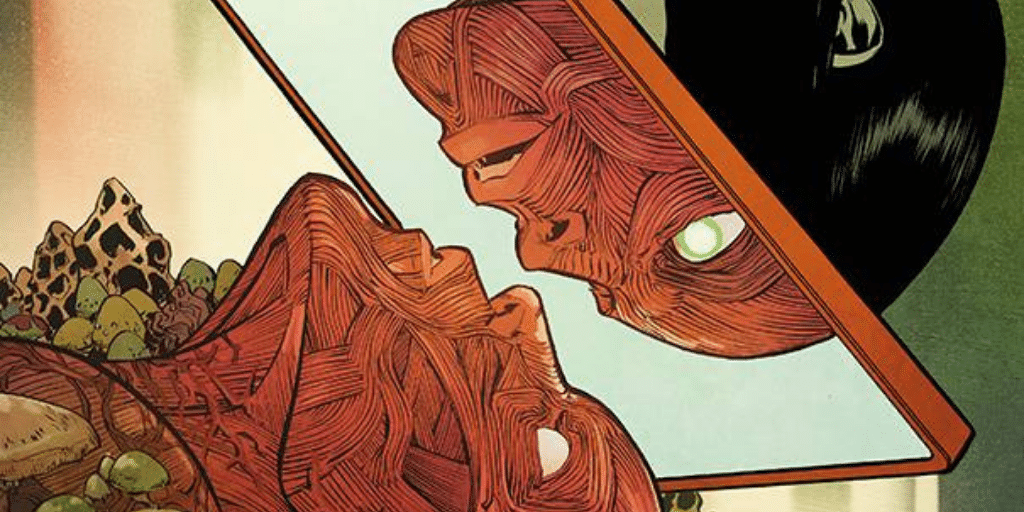
The second issue also starts with a flashback. The unknown entity reappears, and we see a man covered in spores and what seems like mushrooms. It is another premonition; it looks like the narrator, Bramwell, mentions how we are all just nodes living inside one superorganism.
Back in the present, Anne and her co-workers lean into the violence as the world watches the most wicked Livestream ever broadcasted online. The world transforms in an instant as horrifying desires are revealed, death is transformed into a spectacle, and death is converted into a sensation.
Bramwell asks Anne and Dalton to capitalize on this unfortunate death, saying this is what the viewers want. We get to take a look behind the scenes of internet indignation to uncover who’s pulling the strings, become those who push the boundaries of what is acceptable, deny accountability, and gain billions while doing so.
Milo Caliban’s terrible live suicide is currently being meticulously orchestrated in order to keep his fans in a frenzy. While Anne/Zoe and Dalton are putting on a show, the grand architect is unmistakably Bramwell Caliban. But terrifying spectacle and stock prices aside, there’s something even eviler and horrible lurking beneath this man’s actions, who, however cold and cruel, should be grieving his son’s death.
The ongoing dissection of Milo Caliban is harrowing, not just because of the act itself (which is a whole world of being screwed up), but also because of the way it reveals the true nature of those behind this media circus. Dalton truly believes that Bramwell has a way to fix this and bring the boy back to life.
It is easy to appreciate Dalton’s intentions, but only up to a point. He’s witnessed brutality and war, he’s been through the meat grinder and came out the other side, and he owes Bramwell Caliban his life. While that kind of loyalty can’t be bought, it is usually blind. He appears to be a good man at heart from what I make of it, but there’s no way of knowing whose side he’d take if things went horribly wrong.
Anne, on the other hand, is a different story. She plays tough, icy, and selfish, yet her raison d’être is to provide a better life for her daughter and potentially become a person who can be a part of that life, no matter how hard she tries to hide it. It’s both exciting and scary to see how far she’ll go to attain that objective and whether or not the person she becomes, in the end, is even capable of being that person.
He makes Dalton and Anne dissect Mylo’s body and view it for a live audience. Dalton gives a running commentary of each body part while somehow, despite all the gore, the view count keeps increasing. During the dissection, they find something unknown in Mylo’s body, which finally stops the live stream.
Bramwell, meanwhile, starts planning “Mylo’s Rebirth Campaign” with his board members. He proposes to Livestream Mylo’s head being eaten by a couple of dogs. He wishes to terrify Mylo’s followers and anyone willing to watch. I don’t know about the rest of the audience, but I’m terrified, not just by the thought of feeding the child’s head to dogs, but of Bramwell Caliban.
He reminds me of a colder, less charismatic version of Mads Mikkelsen’s Hannibal Lecter. Caliban is dangerous and unpredictable because he lacks any sense of accountability or fear of punishment. All that money, all that power, complete control over a mysterious and sinister technology, the knowledge that you can do anything you want with no consequences, and the superego that allows you to feel that anything you do is justified because it’s you who’s doing it. In this issue, it’s clear that part of whatever game he’s playing is seeing how far he can push Anne.
The idea of profiting from an influencer’s live suicide and autopsy is more disturbing than the actual imagery at work here, which is horrifying in and of itself: Every dish Bramwell serves seems like the intestines of some eldritch Lovecraftian horror, Dalton is clearly a ghoul-servant, and the ‘dogs’ resemble werewolves suspiciously.
Bad Debt Symbiosis
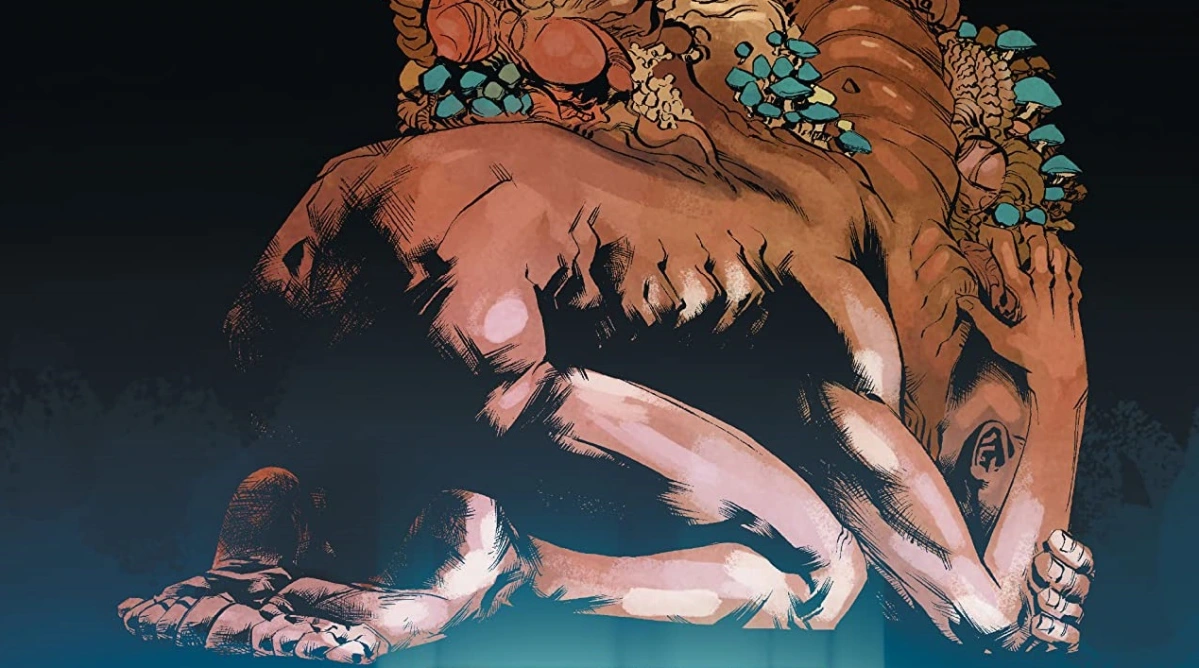
The third chapter depicts some of Bramwell’s more bizarre and evil parts of the universe he has created for himself. Yes, there is something even worse than what has been happening in the series so far. We’re introduced to the entities that provided him the ability to change the world, as well as a hint of how far he’ll go to reach his as-yet-unknown ultimate aim.
Perhaps we’ve just seen a glimpse of how terribly he misread his victory. He wins a game against the nameless entity. She is something that is omnipresent, especially in the form of spores. The entire narrative and the general fungal theme start to come together with this revelation. He gets the medallion from her, which we have been seeing so far. It is the tool to reshape death.
Coming back to the present, we find that Bramwell Caliban is reveling in the horror as the broadcast of Mylo Caliban’s deconstruction has reached an unimaginably sadistic level. The crime he is doing has such a worldwide impact that it is affecting economies around the world. It explores Anne, Bramwell’s hired content producer, as she begins to question whether the money and stock she’s collecting for the heinous things they’re doing with Mylo’s body is indeed worth it.
This is also the first issue in which we see the psychological toll that our two major protagonists, media directors Anne Stewart and her editor Dalton, have taken. Anne/brain Zoe’s is splintering as the emotional agony of what she’s doing shatters her psyche into two parts: a mother wanting to reconcile with her daughter and a woman so repulsed by what she’s done that she questions whether she deserves to be a part of her daughter’s life.
The two of them have been ordered to broadcast the destruction of Bramwell’s son Mylo, who was the face of MyCee and a well-known social media influencer around the world. All of this was accomplished through advertising and plans for an “Own a Piece of Mylo” campaign, with Bramwell designing “trinkets created from his skin” in a ghoulish and heartless manner. Fingernail fragments If we’re lucky, we’ll be able to save our teeth. Necklaces are made from veins. We’ll make money out of every inch of him.” Attempting cynically to cloak everything under the mantle of “art.”
Dalton is the one who suffers the most as a result of this exploitation. He recognizes that the more Mylo’s body is dismembered and parcelled out like a sacrificed lamb sold to a butcher shop, the greater the toll it would exact not only on his sanity and soul but also on the millions — and counting! — of spectators that Bramwell publicly wishes to desensitize into servitude.
Andy MacDonald beautifully depicts Dalton’s remorse and anguish over Mylo, whom he truly cared about, as well as his own spiraling downward in a particularly subtle yet emotional panel. While Anna, whose actual name is Zoe and who is also a parent, is depicted battling her own sense of cynical desensitization.
She begins to comprehend the ramifications of exploiting Mylo’s death and its aftermath to the tune of peak media saturation, increased viewership, and ballooning MyCee stock prices, where it may have once been utilized as a defense mechanism (hinted at since the first issue). We see an entity approach, Anne, as well. It starts to sway her and tries to get in touch with her softer side, the one that cares more about her daughter than about money.
The issue concludes mysteriously and brutally, laying the stage for the future battle in which this world, like the hedonistic, debased Frank Cotton, will be condemned in search of its own fetishized and intellectualized craving for thrill and spectacle, no matter the cost. It leaves us reeling from Dalton’s suicide in Mylo’s name. The chapter ends with a gory image of Dalton kneeling with his intestines hanging out of his body.
It’s frightening enough that Zac Thomson can create these twisted dreams, let alone form them into something to share with the rest of the world. However, that being said, what Thompson does give here is masterfully wrought, and as a horror fiction enthusiast, it never ceases to amaze me how effortlessly he can write something that you know would be incredibly horrible yet has a subtle elegance that draws you in and keeps you off-kilter all the way to the conclusion.
Invisible Hyphae Arteries
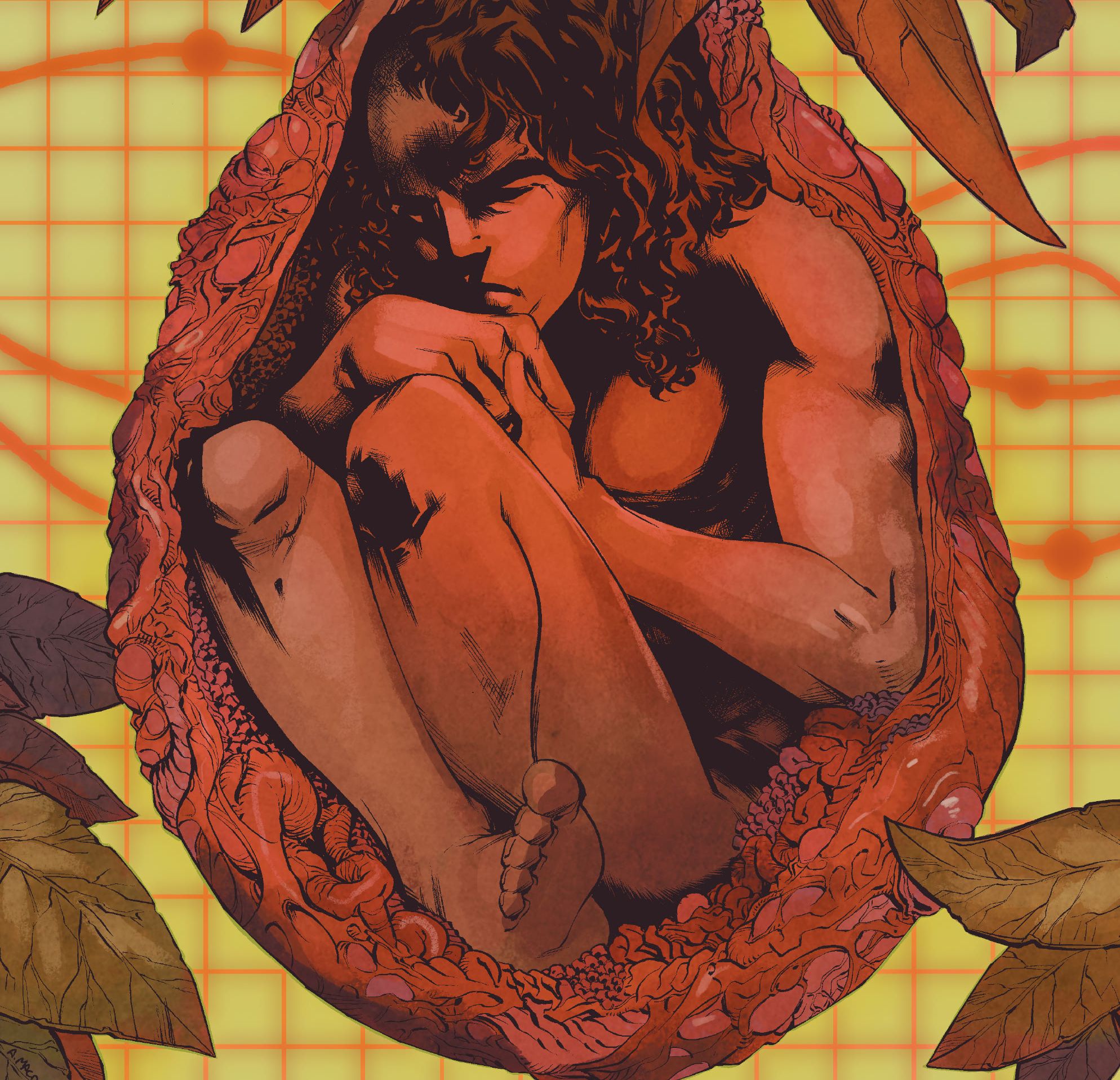
Thompson starts this chapter by showing us the entity, Bramwell, and a child sitting in front of the fungal hyphae. Bramwell talks about the Symborg 1, which was part fungus, part recycled polycarbonate, aluminum, and magnesium, and part 4000 dead individuals. This premonition starts to make sense almost immediately.
By this time, the world has been inundated with statement art about the subject, almost all of which appears to take itself very seriously. Projects making pseudo-political, anti-social media comments have a pompous air about them, as if each project believes it is making an edgy or somehow new, unrecognized point about our current dependency on, and overindulgence in, the social media environment. The truth is that everyone recognizes the system’s intrinsic toxicity.
Zoe tries to escape the madness that Bramwell seems to be making her a part of. Still, before she can leave, Bramwell, the CEO of the mega-corporation Mycena, has begun a ritual to resurrect his dead son, Mylo. He brings a mysterious and misshapen boy as a replacement for Mylo for the ritual process. The latter had mistakenly committed suicide in the first issue itself.
The entire world appears to be going to hell — literally — following the act of hara-kiri (a ritual suicide) done by Dalton at the end of I Breathed a Body #3. He stops her from leaving by showing her a video of her daughter, Abigail, being willing to end her life for Mylo on her MyCee account. He promises to delete Abigail’s page and block her IP address from the site if she stays and helps him with the ritual.
She stays for her daughter and deals with the ongoing battle inside her. She keeps feeling guilty about everything she has done so far and how she has been influencing the media. The unknown entity starts trying to talk to her yet again. It warns her not to eat the food Bramwell is giving her, saying it will kill her. It keeps influencing her and telling her to break the barrier and betray Bramwell.
On the third day of the ritual, we see the deformed boy. He is introduced to Mylo’s fans. Mylo is said to be the Gelbacut fungus in the boy’s arms – neither living nor dead. Bramwell and Anne place a lot of mushrooms and funguses around the boy in the shape of an 8. He gave the medallion to the boy and said that it would keep him safe. They start live streaming the ceremony for people everywhere to watch.
The boy begins speaking like Mylo and asks his fans to give him their blood. He asks them to spill their blood on the ground, which is a vague way to ask them to commit hara-kiri. His fans are fanatics, and they start to do just that. They begin to live streaming their acts of hara-kiri and claim it to be for Mylo. Bramwell’s floor starts swarming with a patterned current of blood which is required for the ritual, it seems.
Before the ritual can succeed, Anne decides to listen to the nameless entity, steals the boy’s medallion, and runs. The entity, known as the First American, wanted Anne to use the medal to sacrifice herself. Instead, she throws it onto the ground. The protection circle, it turns out, wasn’t to keep Anne inside but rather to keep the First Americans out.
The plot hovers as breathlessly on the edge of action in this, the penultimate issue, as it has in the previous three; plenty of fungi have been painstakingly placed, a lot of blood has been spilled, and the issue finishes with a ritual in full swing, but I still can’t figure out why I’m here. The ground opens up, and there is an underworld of a city peeking from it. Thompson leaves us highly confused and wanting more.
Into the Underland
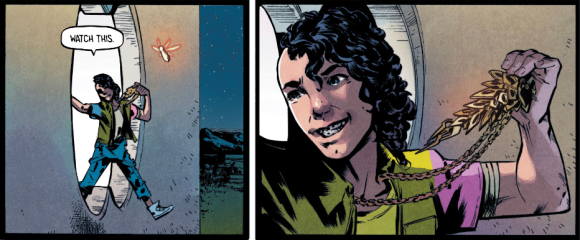
As the world wars, and thoughts combine, and Anne/reality Zoe falls around her, the Gateway to the Underland has opened, and the fungus God of the Gelbacut has stepped through the doorway seeking revenge. She must struggle to stop Bramwell’s twisted nightmare vision with the unexpected help of the children and eventually choose between saving the world or saving herself.
A primordial form of the first American appears, and she starts to reform herself using other bodies. During this time, Anne goes to protect Mylo, who tells her to hide in a small place. She begins to crawl along with the space till she feels soil around her. She falls into the first-ever lab where Mycena was developed and found multiple misshapen boys.
They start calling her mother and show her a video about their and Mylo’s existence, mainly as Gelbacut fungus. Over the years, it turns out, Bramwell has attempted to make a bunch of Mylos. The one who ended up giving his life was the only successful one. This might explain the lack of grief over his death, but it still doesn’t settle well with me.
As the story progresses, we see that the kids are actually calling the First American their mother. Anne is in the vents with the other children as she eavesdrops on Bramwell’s conversation with the First American. During this conversation, she realizes that they are, or at least were, lovers.
Just then, almost as if Bramwell has sensors in his brain, he finds Anne watching and spying. He asks the deformed Mylo to kill Anne while he lives streams it. Thankfully, he is unable to go through with it as the other deformed children come to her rescue. They decide to attack Bramwell, or daddy, as they call him. They end up eating him, and the deformed Mylo records all of it.
Anne decides to kill the entity and end this entire nightmare. She figures out the entity’s name, allowing her to gain power. However, Vedma (the entity) asks Anne to play the same game as Bramwell. If she wins, then Vedma recreates the world in her image, and if Vedma wins, then Anne has to give up her name. she loses the bet and has to give up her name.
Both her identities, Zoe, and Anne, are lost, and she gains a different one. Her abandoned daughter would forget about her, and she would be cared for. There’s a lot going on in this last issue, yet the story is so well-woven that it never feels overpowering.
When the dust has settled, Ann/ultimate Zoe’s trial is presented in an almost peaceful manner. Despite the fact that it is a finale that would not have been out of place in the workings of The Engineer of the Cenobites, it has a sense of calm and beauty about it. She becomes a Gelbacut.
The entire series has been a masterfully created nightmare that might have come from Barker, Cronenberg, or Lynch’s pen. That said, the final act is always the one that concerns me the most because a satisfactory finale to this kind of story requires a Barker, a Cronenberg, or a Lynch. This issue’s conclusion feels both startling and inevitable, as it is a natural extension of the rest of the book.
I found myself focusing on the social media business parts of this story rather than what turned out to be a more essential issue here — motherhood — when reading (and writing about) this series. Indeed, the tale in this last issue shows something that has been evident all along: this is a story about parents, the future, and the society we create for future generations, all of which should have been obvious given the contents of the first issue’s opening page.
Why should you read I Breathed a Body?
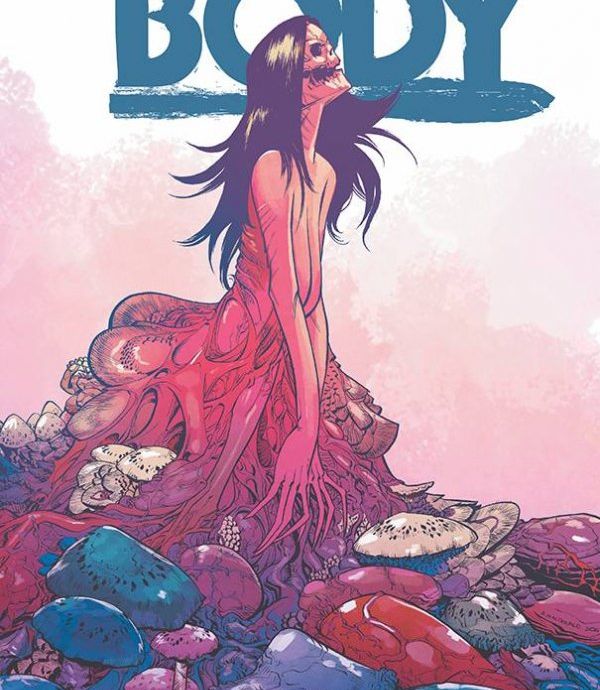
I found this to be a very enjoyable read, the kind of novel that allows you to completely disconnect from your desire to understand everything and instead simply let the whole thing wash over you, transporting you to a state of surrealism and fuzzy consciousness. This will not be a narrative that all readers will enjoy.
That is something I can be realistic about. Some of what happens here will irritate some people, but those who come to this narrative with an open mind will leave with a lot to think about, to the point where they reflect on what they’ve just witnessed at random moments throughout their day.
This story has been about identity and the overabundance of attention and validation that has resulted from technological advancements in social media and instant communication. It’s also about those who make us into a commodity, crafting and packaging our soundbites and frequently worthless commentary for profit.
This is just as much a horror narrative as any of the eldritch, strange. Often horrific happenings in the story since this is the world we’re creating for ourselves, where, like Mylo, we risk losing everything we are, or dreamed of becoming, to a monstrous machine that will consume us down till we drop dead for profit.
This story also explores how we mold the world around us to fit our own vision of it. This series has also been a tour de force in terms of conveying the kind of horror that seeps under your skin and makes you itch for days, thanks to the voyeurism of violence in the irredeemably horrific online contributes, in large part to the fact that, I Breathed a Body, is visually magnificent with every panel and page being perfect.
